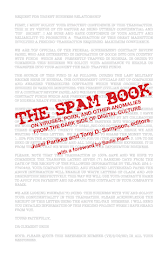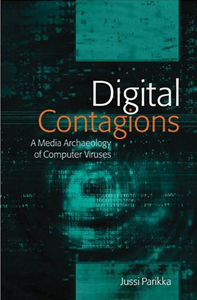What the conference did offer in addition to good social fun was a range of presentations on the topic that is defined in so many differing ways; whether in terms of conflation it with "emotions" and "feelings", or then trying to carve out the level of affect as a pre-conscious one; from a wide range of topics on affective labour (Melissa Gregg did a keynote on white collar work) to aesthetic capitalism (Patricia Clough for example) which in a more Deleuzian spirit insisted on the non-representational. (If the occasional, affective reader is interested in a short but well summarizing account of differing notions of affect to guide his/her feelings about the topic, have a look at Andrew Murphie's fine blog posting here - good theory topped up with a cute kitty.)
My take was to emphasise the non-organic affects inherent in technology -- more specifically software, which I read through a Spinozian-Uexkullian lense as a forcefield of relationality. Drawing on for example Casey Alt's forthcoming chapter in Media Archaeologies (coming out later this year/early next year), I concluded with object-oriented programming as a good example of how affects can be read to be part of software as well so that the technical specificity of our software embedded culture reaches out to other levels. Affects are not states of things, but the modes in which things reach out to each other -- and are defined by those reachings out, i.e. relations. I was specifically amused that I could throw in a one-liner of "not really being interested in humans anyway" --- even better would have been "I don't get humans or emotions", but I shall leave that for another public talk. "I don't do emotions" is another of my favourite one's, that will end up on either a t-shirt or an academic paper.
The presentation was a modified version from a chapter that is just out in Simon O'Sullivan and Stephen Zepke's Deleuze and Contemporary Art-book even if in that chapter, the focus is more on net and software art. I am going to give the same paper in the Amsterdam Deleuze-conference, but as a teaser to the actual written chapter, here is the beginning of that text from the book...
1 Art of the Imp
 erceptible
erceptible In a Deleuze-Guattarian sense, we can appreciate the idea of software art as the art of the imperceptible. Instead of representational visual identities, a politics of the art of the imperceptible can be elaborated in terms of affects, sensations, relations and forces (see Grosz). Such notions are primarily non-human and exceed the modes of organisation and recognition of the human being, whilst addressing themselves to the element of becoming within the latter. Such notions, which involve both the incorporeal (the ephemeral nature of the event as a temporal unfolding instead of a stable spatial identity) and the material (as an intensive differentiation that stems from the virtual principle of creativity of matter), incorporate ‘the imperceptible’ as a futurity that escapes recognition. In terms of software, this reference to non-human forces and to imperceptibility is relevant on at least two levels. Software is not (solely) visual and representational, but works through a logic of translation. But what is translated (or transposed) is not content, but intensities, information that individuates and in-forms agency; software is a translation between the (potentially) visual interface, the source code and the machinic processes at the core of any computer. Secondly, software art is often not even recognized as ‘art’ but is defined more by the difficulty of pinning it down as a social and cultural practice. To put it bluntly, quite often what could be called software art is reduced to processes such as sabotage, illegal software actions, crime or pure vandalism. It is instructive in this respect that in the archives of the Runme.org software art repository the categories contain less references to traditional terms of aesthetics than to ‘appropriation and plagiarism’, ‘dysfunctionality’, ‘illicit software’ and ‘denial of service’, for example. One subcategory, ‘obfuscation’, seems to sum up many of the wider implications of software art as resisting identification.[i]
However, this variety of terms doesn’t stem from a merely deconstructionist desire to unravel the political logic of software expression, or from the archivists nightmare á la Foucault/Borges, but from a poetics of potentiality, as Matthew Fuller (2003: 61) has called it. This is evident in projects like the I/O/D Webstalker browser and other software art projects. Such a summoning of potentiality refers to the way experimental software is a creation of the world in an ontogenetic sense. Art becomes ‘not-just-art’ in its wild (but rigorously methodological) dispersal across a whole media-ecology. Indeed, it partly gathers its strength from the imperceptibility so crucial for a post-representational logic of resistance. As writers such as Florian Cramer and Inke Arns have noted, software art can be seen as a tactical move through which to highlight political contexts, or subtexts, of ‘seemingly neutral technical commands.’ (Arns, 3)
Arns’ text highlights the politics of software and its experimental and non-pragmatic nature, and resonates with what I outline here. Nevertheless, I want to transport these art practices into another philosophical context, more closely tuned with Deleuze, and others able to contribute to thinking the intensive relations and dimensions of technology such as Simondon, Spinoza and von Uexküll. To this end I will contextualise some Deleuzian notions in the practices and projects of software and net art through thinking code not only as the stratification of reality and of its molecular tendencies but as an ethological experimentation with the order-words that execute and command.
The Google-Will-Eat-Itself project (released 2005) is exemplary of such creative dimensions of software art. Authored by Ubermorgen.com (featuring Alessandro Ludovico vs. Paolo Cirio), the project is a parasitic tapping in to the logic of Google and especially its Adsense program. By setting up spoof Adsense-accounts the project is able to collect micropayments from the Google corporation and use that money to buy Google shares – a cannibalistic eating of Google by itself. At the time of writing, the project estimated that it will take 202 345 117 years until GWEI fully owns Google. The project works as a bizarre intervention into the logic of software advertisements and the new media economy. It resides somewhere on the border of sabotage and illegal action – or what Google in their letter to the artists called ‘invalid clicks.’ Imperceptibility is the general requirement for the success of the project as it tries to use the software and business logic of the corporation through piggy-backing on the latter’s modus operandi.
What is interesting here is that in addition to being a tactic in some software art projects, the culture of software in current network society can be characterised by a logic of imperceptibility. Although this logic has been cynically described as ‘what you don’t see is what you get’, it is an important characteristic identified by writers such as Friedrich Kittler. Code is imperceptible in the phenomenological sense of evading the human sensorium, but also in the political and economic sense of being guarded against the end user (even though this has been changing with the move towards more supposedly open systems). Large and pervasive software systems like Google are imperceptible in their code but also in the complexity of the relations it establishes (and what GWEI aims to tap into). Furthermore, as the logic of identification becomes a more pervasive strategy contributing to this diagram of control, imperceptibility can be seen as one crucial mode of experimental and tactical projects. Indeed, resistance works immanently to the diagram of power and instead of refusing its strategies, it adopts them as part of its tactics. Here, the imperceptibility of artistic projects can be seen resonating with the micropolitical mode of disappearance and what Galloway and Thacker call ‘tactics of non-existence’ (135-136). Not being identified as a stable object or an institutional practice is one way of creating vacuoles of non-communication though a camouflage of sorts. Escaping detection and surveillance becomes the necessary prerequisite for various guerrilla-like actions that stay ‘off the radar.’







